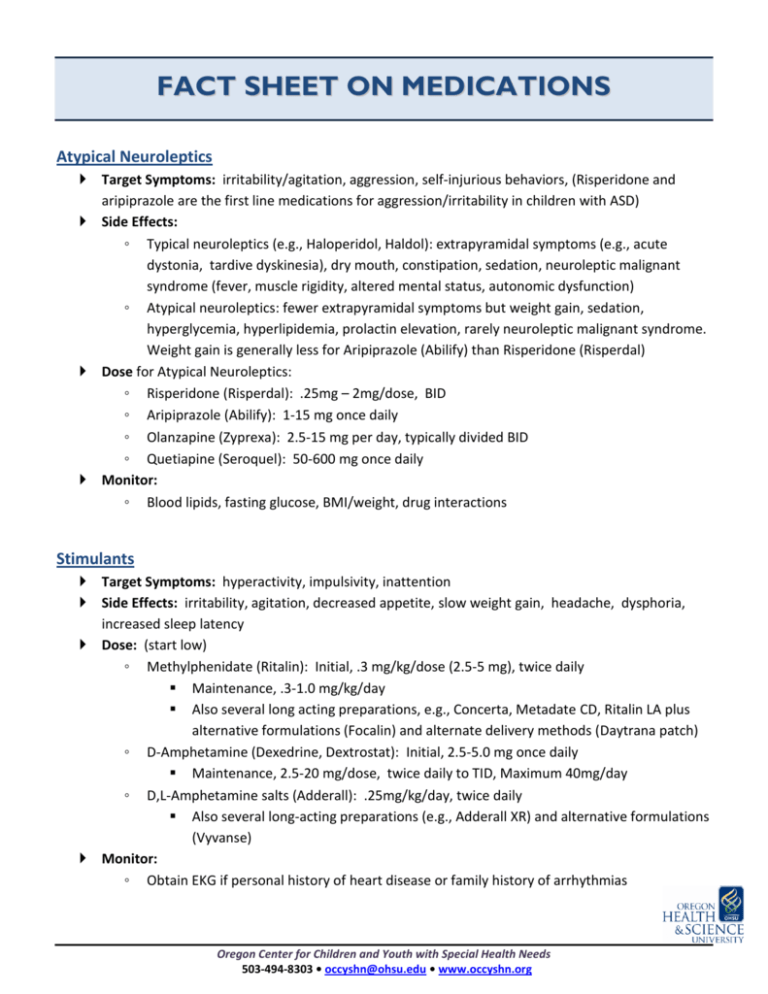FACT SHEET ON MEDICATIONS
advertisement

FACT SHEET ON MEDICATIONS Atypical Neuroleptics Target Symptoms: irritability/agitation, aggression, self-injurious behaviors, (Risperidone and aripiprazole are the first line medications for aggression/irritability in children with ASD) Side Effects: ◦ Typical neuroleptics (e.g., Haloperidol, Haldol): extrapyramidal symptoms (e.g., acute dystonia, tardive dyskinesia), dry mouth, constipation, sedation, neuroleptic malignant syndrome (fever, muscle rigidity, altered mental status, autonomic dysfunction) ◦ Atypical neuroleptics: fewer extrapyramidal symptoms but weight gain, sedation, hyperglycemia, hyperlipidemia, prolactin elevation, rarely neuroleptic malignant syndrome. Weight gain is generally less for Aripiprazole (Abilify) than Risperidone (Risperdal) Dose for Atypical Neuroleptics: ◦ Risperidone (Risperdal): .25mg – 2mg/dose, BID ◦ Aripiprazole (Abilify): 1-15 mg once daily ◦ Olanzapine (Zyprexa): 2.5-15 mg per day, typically divided BID ◦ Quetiapine (Seroquel): 50-600 mg once daily Monitor: ◦ Blood lipids, fasting glucose, BMI/weight, drug interactions Stimulants Target Symptoms: hyperactivity, impulsivity, inattention Side Effects: irritability, agitation, decreased appetite, slow weight gain, headache, dysphoria, increased sleep latency Dose: (start low) ◦ Methylphenidate (Ritalin): Initial, .3 mg/kg/dose (2.5-5 mg), twice daily Maintenance, .3-1.0 mg/kg/day Also several long acting preparations, e.g., Concerta, Metadate CD, Ritalin LA plus alternative formulations (Focalin) and alternate delivery methods (Daytrana patch) ◦ D-Amphetamine (Dexedrine, Dextrostat): Initial, 2.5-5.0 mg once daily Maintenance, 2.5-20 mg/dose, twice daily to TID, Maximum 40mg/day ◦ D,L-Amphetamine salts (Adderall): .25mg/kg/day, twice daily Also several long-acting preparations (e.g., Adderall XR) and alternative formulations (Vyvanse) Monitor: ◦ Obtain EKG if personal history of heart disease or family history of arrhythmias Oregon Center for Children and Youth with Special Health Needs 503-494-8303 • occyshn@ohsu.edu • www.occyshn.org Fact Sheet on Medications ◦ ◦ Blood Pressure, Growth Contraindicated in glaucoma Alpha 2A Adrenergic Agonists Target Symptoms: hyperactivity, impulsivity, aggression Side Effects: sedation, headache, nausea, hypotension (rare), rebound hypertension if medication is rapidly discontinued (dosage must be tapered before discontinuing) Dose: ◦ Clonidine (Catapres): .025-.1 mg/dose, BID-TID ◦ Guanfacine (Tenex): .5-1 mg/dose, BID And a long-acting formulation (Intuniv: .05-.12 mg/kg/day, once daily) Monitor: ◦ Blood Pressure Strattera (atomoxetine): Selective norepinephrine reuptake inhibitor Target Symptoms: hyperactivity, impulsivity, inattention Side Effects: sedation, decreased appetite, nausea and vomiting, dizziness, syncope, mood swings, possible liver toxicity Dose (treatment effects not seen till several weeks after starting the medication): ◦ 1.0-1.4 mg/kg/day, once daily Monitor: ◦ BP. Growth, drug interactions, plus potential increased suicide risk similar to other antidepressants ◦ Contraindicated in narrow angle glaucoma Selective Serotonin Reuptake Inhibitors (SSRI’s) Target Symptoms: repetitive behaviors, anxiety, depression Side Effects: agitation, irritability, dis-inhibition, GI symptoms, headache, insomnia, tremor, sexual dysfunction. Review interaction with other medications, potential serotonin syndrome with overdosage Dose (treatment effects not seen till several weeks after starting the medication): (start very low) ◦ Prozac: 4-40 mg, once daily ◦ Zoloft: 12.5-200 mg, once daily ◦ Celexa: 10-40 mg, once daily ◦ Luvox: 50-300 mg daily, given BID ◦ Lexapro: 5-20 mg, once daily Oregon Center for Children and Youth with Special Health Needs 503-494-8303 • occyshn@ohsu.edu • www.occyshn.org Fact Sheet on Medications Monitor ◦ Interaction with other medications, Black Box warning on suicide risk ◦ Contraindicated if patient taking MAO inhibitor Mood Stabilizers (challenging to use in children with ASD!) Target Symptoms: manic symptoms, aggression, bipolar disorder Side Effects: ◦ Valproic acid (Depakene): weight gain, GI symptoms, headaches, drowsiness, dizziness, insomnia, hair loss, potential for liver injury ◦ Other Anticonvulsants: GI symptoms, insomnia, coordination problems, weight loss with Topiramate (Topamax); rare serious side effects including Stevens Johnson syndrome with Carbamazapine (Tegretol) especially if Asian ancestry and Lamotigine (Lamictal), possible liver toxicity, bone marrow depression and increased suicidal risk with Carbamazapine (Tegretol) ◦ Lithium: potential for serious side effects (problems concentrating urine, excessive thirst, arrhythmias, ataxia) plus hypothyroidism, GI symptoms, tremor, sedation, blurred vision Dose: ◦ Valproic acid (Depakene): Initial, 10-15 mg/kg/24 hr, divided BID to TID Maintenance, 30-60 mg/kg/24 hr, divided BID to TID ◦ Lithium: Initial for child, 15-60 mg/kg/24 hr, divided TID to QID Adjust dose for therapeutic level, .6-1.5mEq/L Monitor: ◦ Drug interactions ◦ Valproic acid (Depakene) and Lithium require frequent blood draws for monitoring drug levels and potential side effects ◦ Valproic acid (Depakene) contraindicated if liver disease, Lithium contraindicated if severe cardiovascular or renal disease Oregon Center for Children and Youth with Special Health Needs 503-494-8303 • occyshn@ohsu.edu • www.occyshn.org





